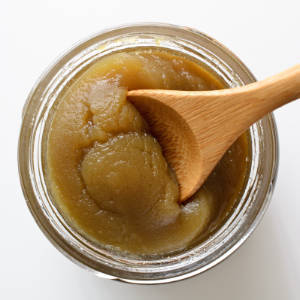Asian condiments Category

Asian barbecue sauce
This is made with oil, soy sauce, and other seasonings. Don't confuse it with the much sweeter American barbecue sauce.
Learn morebanana catsup
Available in Asian food stores. This brownish sauce is often colored red to resemble tomato catsup.
Learn morebean sauce
This salty brown sauce is made from fermented soybeans, and is available in cans or jars. If you buy it in a can, transfer it into a jar. It can then be stored indefinitely in the refrigerator. Chinese bean sauce isn't as salty as Thai bean sauce.
Learn moreblack bean sauce
This is made from fermented black beans. A variation is hot black bean sauce, which has chile paste added, and black bean sauce with garlic. See the Asian Black Bean Sauce posting on RecipeSource.com.
Learn morechee hou sauce
This braising sauce is made from soybeans, garlic, and ginger. Look for it in the condiments section of Asian markets
Learn morechile paste
This is a blend of hot chile peppers, garlic, oil, and salt that's commonly used in Asian cuisine. Includes: Chinese chile (or chili) paste = Szechuan chile (or chili) paste = Sichuan chile (or chili) paste = chile paste with garlic, Korean chile paste, and Vietnamese chile paste = tuong ot toi Vietnam = prik kaeng, which is hotter than the Chinese chile paste. See also separate entries for these other chile pastes: nam prik pao, chile bean paste, sambal oelek, and sambal bajak.
Learn morechili bean paste
This reddish-brown sauce is made from fermented soybeans and hot chilies. It's very hot.
Learn morecoconut egg jam
Southeast Asians spread this exquisite jam on toast, but it would also be great on ice cream. Look for small cans of it in Asian markets. Visit the Coconut Egg Jam recipe page, or the Kaya, Traditional Coconut Jam page.
Learn morefish sauce
Fish sauce is typically made from anchovies or other small fish fermented in salt. It is used to flavor many dishes. It is very common in Asian cooking. The romans called it Garum and it was a widely used flavoring in Roman times. Filipino fish sauce that isn't as highly regarded as the Vietnamese or Thai versions, and shottsuru, a Japanese fish sauce. Red Boat, a Vietnamese fish sauce, is thought to be very similar to garum.
Learn moregochujang
Gochujang is a spicy Korean fermented chili condiment. It is made by with chili powder, glutinous rice and soybeans. It is traditionally fermented in clay pots. Gochujang is often added to the Korean dish bibimbap.
Learn morehoisin sauce
This is a sweet and garlicky bean sauce that's often used as a dipping sauce. Available in Asian markets and in many large supermarkets.
Learn morekecap manis
This thick, dark sauce is the Indonesian ancester of ketchup. Look for it in Indonesian markets.
Learn morenam prik pao
This paste is made from chilies, onions, sugar, shrimp paste, fish sauce, and sometimes tamarind. It's sold in jars, and comes in different strengths, ranging from hot to mild.
Learn moreoyster sauce
This Cantonese dipping sauce is both sweet and salty. Look for bottles of it in Asian markets and large supermarkets.
Learn morered sweet bean paste
This is made from azuki beans, and Asian cooks use it to fill buns and dumplings and to make puddings. Like peanut butter, it comes in both creamy and crunchy versions. The creamy version also comes in powdered form. Don't confuse this with sweet bean paste, which is made from sweetened fermented soybeans.
Learn moresambal manis
This Indonesian sauce is used for dipping and stir fries. It's fairly spicy, but milder than sambal oelek.
Learn moresilken tofu
This Japanese tofu is soft and creamy and it's the preferred tofu for shakes, dips, custards, puddings, and dressings. It's available either fresh in tubs or in aseptic packages that don't need refrigeration. When working with silken tofu, it's a good idea to make a dish ahead of time so as to allow the tofu to absorb other flavors. Don't freeze it.
Learn moresoy sauce
Soy sauce is made from soybeans that have been fermented and salted. It's used throughout Asian, with different regions producing quite different variations. Japanese soy sauce = shoyu is sweeter and less salty than Chinese soy sauce. Chinese soy sauce comes in light and dark versions. Lite soy sauce has 1/3 less sodium.
Learn more

































































































































































































































































































































































